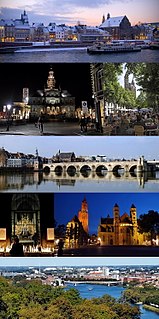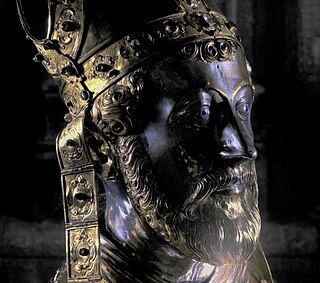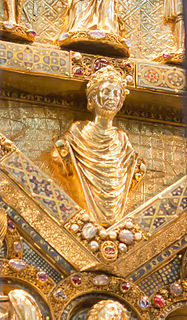
Maastricht is a city and a municipality in the southeastern Netherlands. It is the capital and largest city of the province of Limburg. Maastricht is located on both sides of the Meuse, at the point where the Jeker joins it. It is adjacent to the border with Belgium.
Pope Victor I was the bishop of Rome in the late second century. He was of Berber origin. The dates of his tenure are uncertain, but one source states he became pope in 189 and gives the year of his death as 199. He was the first bishop of Rome born in the Roman Province of Africa—probably in Leptis Magna. He was later considered a saint. His feast day was celebrated on 28 July as "St Victor I, Pope and Martyr".
Pope Damasus II was the bishop of Rome and ruler of the Papal States from 17 July 1048 to his death on 9 August that same year. He was the second of the German pontiffs nominated by Emperor Henry III. A native of Bavaria, he was the third German to become pope and had one of the shortest papal reigns.

Giles of Rome O.S.A., was a Medieval philosopher and Scholastic theologian and a friar of the Order of St Augustine, who was also appointed to the positions of Prior General of his Order and as Archbishop of Bourges. He is famed as being a logician, producing a commentary on the Organon by Aristotle, and for his authorship of two important works, De Ecclesiastica Potestate, a major text of early 14th century Papalism, and De Regimine Principum, a guide book for Christian temporal leadership. Giles was styled Doctor Fundatissimus by Pope Benedict XIV.

Saint Servatius was bishop of Tongeren —Latin: Atuatuca Tungrorum, the capital of the Tungri—. Servatius is patron saint of the city of Maastricht and the towns of Schijndel and Grimbergen. He is one of the Ice Saints. His feast day is May 13.

Rainald of Dassel was Archbishop of Cologne and Archchancellor of Italy from 1159 until his death. A close advisor to the Hohenstaufen emperor Frederick Barbarossa, he had an important influence on Imperial politics, mainly in the Italian conflict of Guelphs and Ghibellines.

Saint Geminianus was a fourth-century deacon who became Bishop of Modena. He is mentioned in the year 390, when he sent a delegate named Aper to participate in a council called by Saint Ambrose in Milan. From his name, it has been deduced that Geminianus probably belonged to the caste of Roman senators.

Simon de Cramaud was a Catholic bishop, titular Latin Patriarch of Alexandria, and cardinal during the Great Western Schism of the fourteenth and fifteenth centuries.
Johann Wilhelm Ernst Sommer was a Bishop of the Methodist Church, elected in 1946 for service in Germany.

Eike of Repgow was a medieval German administrator who compiled the Sachsenspiegel code of law in the 13th century.

Saint Candidus was a commander of the Theban Legion, which was composed of Christians from Upper Egypt. He is venerated as a Christian saint and martyr.

Tello was the Bishop of Chur from 758/759 until his death. He was the last member of the ecclesiastical dynasty of the Victorids to wield power in Rhaetia through his control of the bishopric. His will is one of the earliest surviving records from Graubünden and is an important source for the history of Rhaetia in the eighth century.

Saint Leudwinus, Count of Treves founded an abbey in Mettlach. He was Archbishop of Treves and Laon. As patron saint of the Mettlach parish, his relics are carried through the town by procession at the annual Pentecost celebration. His feast day is September 23. He was the son of Saint Warinus, the paternal grandson of Saint Sigrada, and nephew of Saint Leodegarius.
Otbert of Liège was bishop of Liège at the end of the eleventh century. He was a major figure in the financing of the First Crusade, and an expansionist.
Victor II was an 8th-century bishop of Chur of the Victorid family which had controlled the bishopric and the province of Rhaetia since the early seventh century.
Victor III was the Bishop of Chur from after 800 until his death. He was the last member of the Victorid family to hold the bishopric of Chur and the secular power in Rhaetia concurrently.

Monulph was a sixth-century bishop of Tongeren and Maastricht, and is revered as a Roman Catholic saint.

Paolo Emilio Sfondrati was an Italian Cardinal.

The Roman Catholic Diocese of Liège is a diocese of the Latin Rite of the Roman Catholic church in Belgium. The diocese was erected in the 4th century, and has a long and complicated history. Currently the diocese is a suffragan of the Archdiocese of Mechelen-Brussels. Its modern version covers the same territory as Belgium's Liège Province, but it was historically much larger.
Saint Falco, sometimes: Falco of Maastricht or of Tongeren, was according to tradition bishop of Maastricht from 495 until 512. He is also venerated as a Roman Catholic saint.
This page is based on this
Wikipedia article Text is available under the
CC BY-SA 4.0 license; additional terms may apply.
Images, videos and audio are available under their respective licenses.













